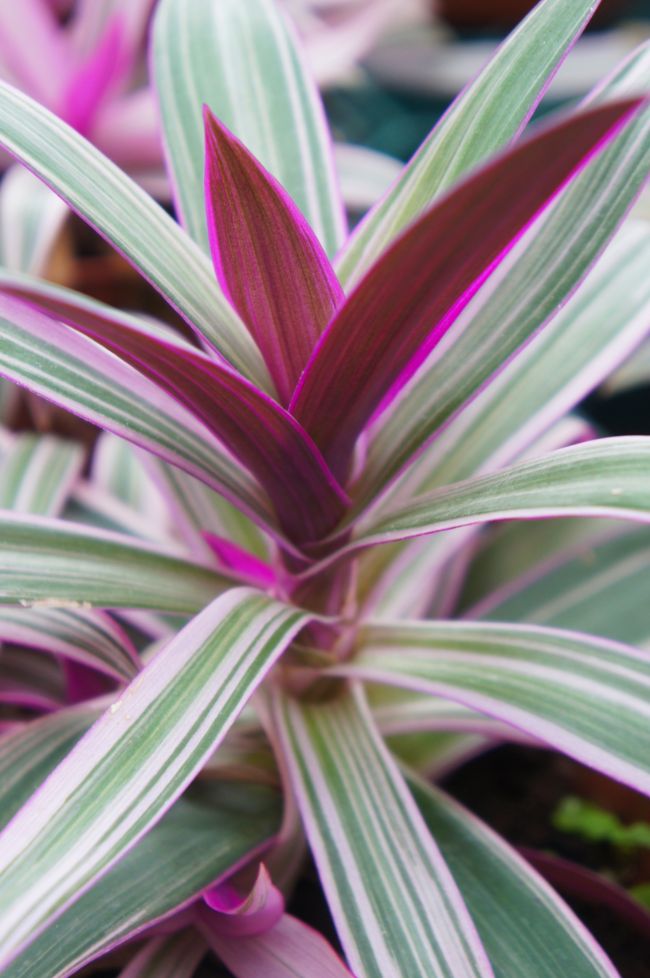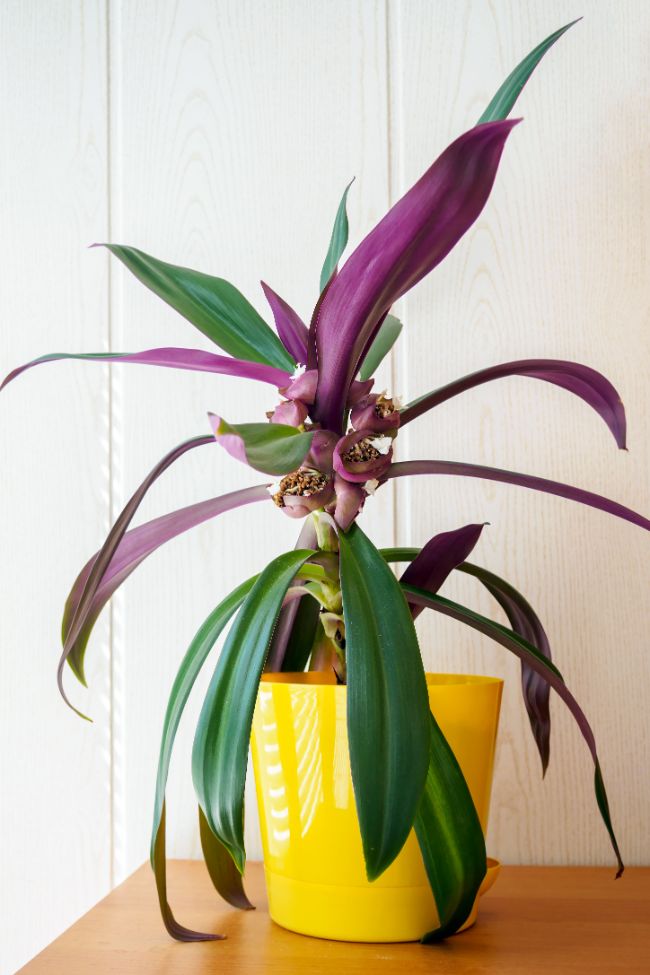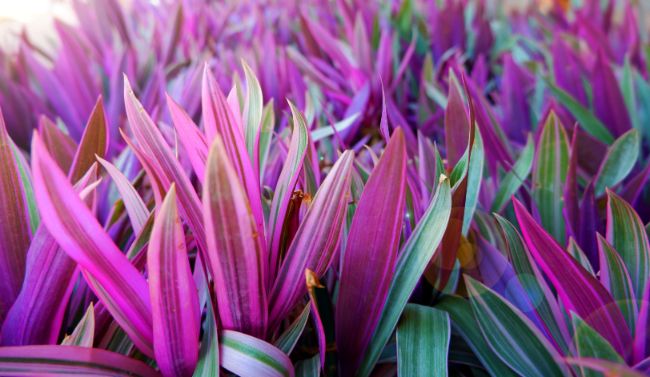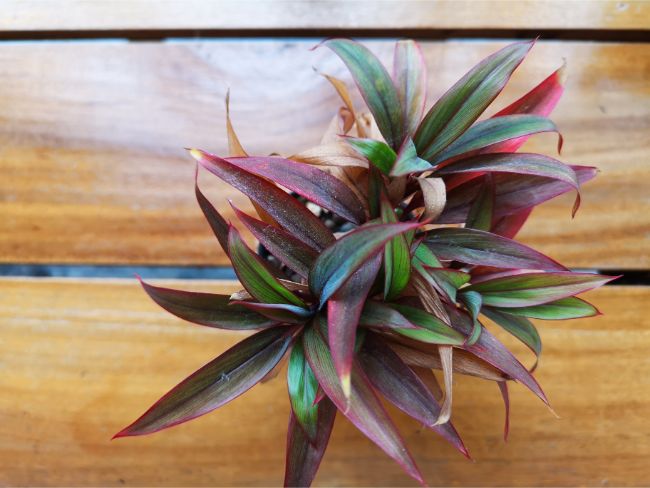Are you looking for an easy to grow houseplant that offers bright colors year-round? Then look no further than the Oyster plant (Tradescantia spathacea) with its bright purple and green foliage. This showy evergreen with its no-fuss habit is a perfect choice for the beginner or those who do not want to tend to high-maintenance plants. Let’s start with a quick summary of oyster plant care, to help you keep yours thriving for years.
Oyster Plant care: Grow your Oyster plant in well draining soil, fertilize monthly during the growing season and water when the top inch of soil becomes dry. Position in bright, indirect light in temperatures of 55-80°F (13-27°C) and ensure moderate to high humidity levels.
Continue reading to learn all you need to know about Oyster plant care and you’ll soon be enjoying a beautiful and vibrant plant that will look stunning in your home.
Oyster Plant Care Summary
- Scientific Name: Tradescantia spathacea
- Common Name: Oyster Plant, Moses in the cradle, Rhoeo, Boat Lily
- Light Requirements: Bright, indirect light. Will tolerate lower light but foliage coloration will be less vibrant.
- Watering: Water thoroughly once the top inch of soil has dried out. Reasonably drought tolerant.
- Soil: Rich well-draining soils are best. Equal parts potting mix, compost and perlite works well.
- Temperature: 65°F (18°C) and 86°F (30°C).
- Fertilizer: Low fertilizer requirements. Monthly during the growing season with a balanced, water-soluble fertilizer. I use this one.
- Humidity: Moderate to high humidity to provide good oyster plant care. >40% ideally.
- Pruning: Low pruning requirements. Remove dead foliage and prune as required to maintain shape.
- Propagation: The mother plant will produce babies attached to side shoots. Remove and repot when about 4 inches tall.
- Re-Potting: Only really needs repotted if outgrowing existing container.
- Diseases and Pests: Fairly resistant to pests. Scale, mealybugs, spider mites and whitefly are sometimes seen, but easily treated. Overwatering will cause root rot.
- Toxicity: Non-toxic to humans and pets.
- Where To Buy: Buy an Oyster Plant online at Etsy (I buy most of my houseplants from Etsy).

Characteristics Of The Oyster Plant
Oyster plant (Tradescantia spathacea) goes by several common names and shouldn’t be confused with another plant commonly known as Oyster plant, Salsify (Tragopogon porrifolius), whose roots are said to taste like oysters.
The ornamental and tropical Oyster plant is native to the warm regions of Guatemala, southern regions of Mexico and Belize and is also known by the names of Boat Lily and Moses-in-the-cradle. It gets the common name Moses-in-the-cradle due to the shape of the flowers, Boat lily due to canoe-shaped leaves and Oyster plant from the flowers that resemble oysters.
Belonging in the genus Tradescantia and related to Wandering Jew plant and Spiderworts, Oyster plants once were listed under the name of Rhoeo discolor and some nurseries may still list them under the old name.
Oyster plants belong in the Commelinaceae family and are considered herbaceous perennials. The genus is named in honor of the gardeners and botanists to Charles I of England, John Tradescant and his son, who goes by the same name.
Oyster plants grow anywhere from 6 to 12 inches tall, with their leaves green on top and with purple undersides forming into a spiral rosette. The lance-shaped leaves grow 6 to 12 inches long and plants average around 12 inches wide, forming into dense clumps. When given enough light, white flowers encased in purple boat-shaped bracts bloom year-round.
Although the standard Oyster plant (Tradescantia spathacea) is the most common type you are likely to find in your local nursery or online plant dealer, you have choices in other varieties or cultivars of Oyster plant with a bit different colored foliage.
- Golden Oyster Plant (Tradescantia spathacea ‘Gold’): Golden leaves striped in green and sometimes tinged in pink with purple undersides.
- Tricolor Oyster Plant (Tradescantia spathacea ‘Tricolor’): Thinner leaves striped in green, pink and cream with purple undersides.
- Dwarf Oyster Plant (Tradescantia spathacea ‘Dwarf’):Smaller Oyster plant only growing about 8 inches tall and with green upper leaves that are purple on the undersides.
Oyster Plant Soil Requirements
Oyster plants are not too fussy about their soil as long as it drains well. If planted in soils that are too heavy, like some types of potting soils they can develop rot and die. However, for the best growth and performance plant in rich soil mediums that are well drained. Fertile and lightweight potting mixes work well. You can also create your own soil mixture by using equal portions of the following:
- Potting soil, coarse sand and compost
- Potting mix and perlite
- Potting soil, perlite and compost
The most important thing to remember when it comes to appropriate soil for your Oyster plant is making sure it drains and doesn’t have a tendency to remain soggy after watering.
If after watering the water remains on top of the container’s soil for a long period before draining, your soil is too heavy. If this happens, it’s best to remove the Oyster plant from the container and lighten the soil mixture by adding additional potting mix, sterile sand or vermiculite.
Oyster Plant Light Requirements
To keep the robust colorations on the Oyster plant’s foliage it’s best to situate in an indoor location receiving bright, indirect light. This is especially true for variegated types like Tricolor.
Although it will tolerate growing in dimmer indoor conditions, the colors will not be as pronounced or as bright. In addition, Oyster plants not receiving enough bright light will have their foliage lose some of the purple and will become greener.
If you’d like to give your Oyster plant a break from growing indoors when outdoor conditions are warm, you can bring the plant outdoors. To keep the foliage from burning, situate in a partially shady location and be sure to bring the plant back indoors before the cold winds and temperatures of winter call.
Oyster Plant Temperature Needs
Oyster plants are native to tropical locations that are consistently warm and only grow as perennials planted outdoors in frost-free locales. To provide good oyster plant care and keep the plant producing healthy growth indoors, place in a location where temperatures range between 55-80°F (13-27°C).
Oyster plants don’t like being in areas where temperatures fluctuate, so position away from drafty doors or windows. In addition, don’t place near a air or heating vent.

How To Water An Oyster Plant
Once established, Oyster plants are relatively tolerant to drought, so it will forgive you if you forget to give it an occasional drink of water. However, if you overwater leaving the soil constantly soggy, the plant can develop rot and die.
While the Oyster plant is actively growing during the growing season of spring through summer, water every time the top inch of soil dries out and thoroughly saturate the soil. During winter, the plant goes into a dormant stage and growth slows, so you’ll cut back and may only have to water every couple of weeks.
For the best results and to assure you don’t overwater, allow the soil to dry a bit before watering. It’s easy to check if your Oyster plant requires a drink by sticking your finger into the soil and if the top inch feels dry to the touch, apply water until it drains from the bottom drain holes. For more information about how to pick the perfect time to water your plants, read this article.
Humidity For Tradescantia Spathacea
Good oyster plant care requires moderate to high humidity for their leaves to remain healthy looking. If conditions are less than ideal, when it comes to humidity, the tips of leaves can turn brown. You don’t have to be a weather professional to create a humid environment for your Oyster plant.
- Sit the Oyster plant’s container on a tray of small pebbles and as the water in the pebble-lined tray evaporates, humidity is created around the plant.
- If light conditions are appropriate in your bathroom, you can grow the Oyster plant there, as the constant use of water in the room creates a humid environment.
- Use an electric humidifier to increase humidity easily.
For more information, read this article about the best ways to increase indoor humidity levels for your plants.
Fertilizer Requirements For Tradescantia Spathacea
Oyster plants aren’t big feeders but regular applications of fertilizer helps produce healthy growth. During the growing season of spring through summer, fertilize the Oyster plant monthly, unless you are using a slow-release blend. During winter, when the plant goes through dormancy and growth slows, stop fertilizing until the weather warms again in springtime.
If you are growing the Oyster plant in a potting mix that contains a slow-release fertilizer, you won’t have to feed again for approximately three months. Most slow-release blends continue feeding the Oyster plant for up to three months at which time you’ll need to apply additional slow-release granules or use a liquid blend instead.
For the best results, use a water-soluble liquid houseplant blend. You can mix the fertilizer into the water and use when you would normally water the plant.
After a while, salts from the fertilizer can buildup in the soil and it requires flushing to remove. Too much salt in the soil can lead to brown leaf tips due to burning, so it’s best to flush the Oyster plant’s soil a couple of times yearly. Flushing the salt from the soil is relatively basic:
- Take the entire container to the sink and allow the water to run slowly through the soil for about five minutes. Allow the water to completely drain and then empty the catch tray and place the Oyster plant back where it was growing.
Pruning Oyster Plants
Pruning requirements for Oyster plants are low. The only time you will need to trim the plant is to remove dead or dying leaves. Trim the leaf off at its base using clean pruning tools.
Cleaning your pruning tool blades assures you don’t transfer any unwanted disease or pests to the plant, which is as easy as wiping the blades off with alcohol.
Planting Tips
Provided your soil mixture drains well and doesn’t retain too much water, you will only have to worry about replanting the Oyster plant when the clump outgrows the present container.
If you just purchased your Oyster plant and want to replant in a container of your choice, just be sure it has bottom drain holes. The plant makes an attractive addition used in regular pots or hanging baskets and even works well mixed with other plants with the same light and water requirements.
Basic planting steps:
- Remove the Oyster plant from its present container. If replanting due to the plant outgrowing its present container, use a new container that is one size larger.
- Fill the new container about a quarter of the way full with a well-drained potting mix. Water the soil to settle it.
- Place the oyster plant into the new container and finish filling with soil.
- Water the soil again and until it runs from the bottom drain holes.
- Situate the container is a bright location receiving indirect light.

Propagating Oyster Plants
As the mother Oyster plant grows and matures, it produces additional plants through side shoots that can be removed and repotted. You can propagate the new plants by gently pulling the developing side shoots from the mother plant. It’s probably best to wait until the new Oyster plants reach about 4 inches tall before removing, as by then they have developed a good root system.
When repotting into a new container, follow the above steps in the planting section to plant the Oyster plant babies.
Disease Problems
Oyster plants are considered relatively free from disease problems other than those caused by rot due to overwatering or growing in soil that is too heavy and retains too much water. When rot becomes a problem the foliage and base of the Oyster plant becomes water soaked and can eventually turn black and mushy. If the rot problem is severe, the Oyster plant can die.
Prevent rot problems by making sure the soil mixture drains well and only apply water when the top inch of soil becomes dry to the touch. If your soil mixture is too heavy and retains too much water, you need to repot the Oyster plant into a lighter soil mix such as what’s found in typical potting mixes.
Pest Problems
Although Oyster plants don’t have any serious pest problems, insects such as mealybugs, spider mites, whiteflies and scale can sometime affect plants. Quick treatment solves the problem and assures the pests don’t migrate to your other indoor plants infecting them too.
All the pests are easily identified, and controlled with the same products.
- Mealybugs: Mealy bugs suck the sap from the Oyster plant’s foliage and show as clumps of white cottony looking masses, typically forming in the crotch of the leaves.
- Whiteflies: Whiteflies are other sap-sucking pests that can quickly injure or kill your Oyster plant if not quickly treated. If you disturb the plant, small white insects will start flying around the top of the Oyster plant.
- Spider mites: Spider mites are another sap-sucker that can quickly damage or kill an untreated Oyster plant. The white, spider-like pests spin a fine webbing over the plant.
- Scale: Scale insects also suck the sap from the Oyster plant. The small, oval pest come in a vast array of colors and have an armored-like shell covering and usually congregating in masses over the foliage.
You can treat all the pests by saturating the Oyster plant’s foliage with neem or by using an insecticidal soap, repeating as directed on the specific product’s label. In addition, if you catch the pest problem at the beginning, you might be able to wipe the pests from the Oyster plant using a damp cloth. Read more information about getting rid of houseplants pests naturally in this article.
Why Are My Oyster Plant’s Leaves Turning Brown?
If the entire leaf of your Oyster plant is turning brown, it could be getting too much direct sunlight and burning, or it’s getting too much water. For the best performance when grown indoors, situate the Oyster plant in a location receiving bright, indirect light and not full direct sunlight.
If sunlight isn’t the problem, you could be overwatering and keeping the soil too moist. Cut back on water applications and only irrigate when the top inch of soil becomes dry to the touch.

Why Are My Oyster Plant’s Leaf Tips Turning Brown?
If you notice the tips of the leaves on your Oyster plant turning brown the plant either isn’t getting enough humidity or it’s suffering fertilizer burns. Improve oyster plant care by increasing humidity around the plant. Use a humidifier, group your plants or place the entire container on a pebble-lined tray.
If lack of humidity isn’t the problem, too much fertilizer or a buildup of salts in the soil is most likely burning the foliage. Only fertilize monthly during the growing season of spring through summer using a water-soluble houseplant blend or every couple of months using slow-release granules.
Flush the soil of any salt buildup several times yearly by taking the plant to the sink and allowing water to run slowly through the soil removing the salts.
My Oyster Plant Leaves Have Tiny White Spots On Them
If the top portions of the Oyster plant’s leaves are covered in tiny white spots, you have a problem with spider mites, which suck out the plant’s juices. Spider mites can quickly damage the Oyster plant so quick action is needed.
Treat the pests by saturating both sides of the Oyster plant’s leaves with neem or insecticidal soap, repeating as suggested on the particular product’s label. Check your other indoor plants, as the spider mites can easily infect other houseplants.
Are Oyster Plants Toxic To Pets?
Oyster plants are not considered toxic to animals.
Are Oyster Plants Edible?
Oyster plants (Tradescantia spathacea) aren’t edible despite the common name and shouldn’t be confused with another plant called Oyster plant, Salsify (Tragopogonporrifolius), an edible root vegetable.

